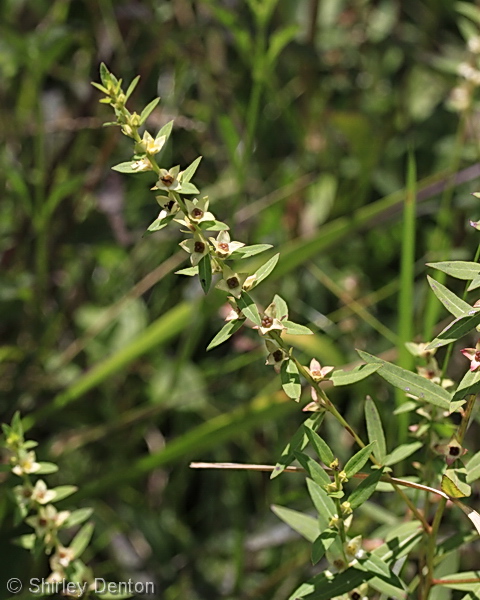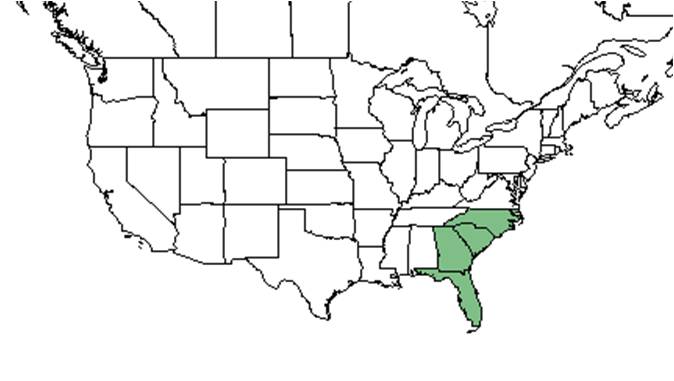Difference between revisions of "Ludwigia lanceolata"
(→Description) |
|||
| Line 22: | Line 22: | ||
==Description== | ==Description== | ||
<!-- Basic life history facts such as annual/perrenial, monoecious/dioecious, root morphology, seed type, etc. --> | <!-- Basic life history facts such as annual/perrenial, monoecious/dioecious, root morphology, seed type, etc. --> | ||
| + | “Repent or erect, usually branched, short-lived perennials, or rarely annual. Floral parts in 4-7’s; hypanthium not prolonged beyond ovary. Capsules longitudinally or poricidally multiseriate, rarely uniseriate. Most of the erect species produce basal offshoots, which have ovate to obovate leaves, in the late summer and fall. Bracteoles occur in pairs on the pedicel or stipe or on the base of the hypanthium.” – Radford et al 1964 | ||
| + | |||
| + | "Similar to L. alata. Seeds cylindric; sepals ca. ½ length of capsules; capsules 4-6 mm long." - Radford et al 1964 | ||
==Distribution== | ==Distribution== | ||
Revision as of 18:47, 3 February 2016
| Ludwigia lanceolata | |
|---|---|

| |
| Photo by Shirley Denton (Copyrighted, use by photographer’s permission only), Nature Photography by Shirley Denton | |
| Scientific classification | |
| Kingdom: | Plantae |
| Division: | Magnoliophyta - Flowering plants |
| Class: | Magnoliopsida – Dicotyledons |
| Order: | Myrtales |
| Family: | Onagraceae |
| Genus: | Ludwigia |
| Species: | L. lanceolata |
| Binomial name | |
| Ludwigia lanceolata Elliott | |

| |
| Natural range of Ludwigia lanceolata from USDA NRCS Plants Database. | |
Common name: lanceleaf primrose-willow
Contents
Taxonomic notes
Description
“Repent or erect, usually branched, short-lived perennials, or rarely annual. Floral parts in 4-7’s; hypanthium not prolonged beyond ovary. Capsules longitudinally or poricidally multiseriate, rarely uniseriate. Most of the erect species produce basal offshoots, which have ovate to obovate leaves, in the late summer and fall. Bracteoles occur in pairs on the pedicel or stipe or on the base of the hypanthium.” – Radford et al 1964
"Similar to L. alata. Seeds cylindric; sepals ca. ½ length of capsules; capsules 4-6 mm long." - Radford et al 1964
Distribution
Ecology
Habitat
In the Coastal Plain in Florida, L. lanceolata can occur in depression marshes, hillside seepages, shallow water of titi-cattail ponds, pine flatwoods, lake edges, between coastal dunes and lakes, and cypress pond pine swamp. It occurs in disturbed areas such as powerline corridors and ditches (FSU Herbarium). Associated species include Bidens laevis, Magnolia, Nyssa, Pickneya, Liquidambar, Quercus, Ludwigia linearis, Juncus trigonocarpus, Fuirena scirpoidea, Xyris fimbriata, Woodwardia, Ludwigia octovalvis, L. decurrens, Rhynchospora chalarocephala, Xyris fimbriata, Bidens mitis, Hypericum cistifolium, Typha, and Juncus repens (FSU Herbarium).
Phenology
Fruits and flowers June through November (FSU Herbarium).
Seed dispersal
Seed bank and germination
Fire ecology
Pollination
The following Hymenoptera families and species were observed visiting flowers of Ludwigia lanceolata at Archbold Biological Station (Deyrup 2015):
Vespidae: Parancistrocerus salcularis rufulus
Use by animals
Diseases and parasites
Conservation and Management
Cultivation and restoration
Photo Gallery
References and notes
Deyrup, M.A. and N.D. 2015. Database of observations of Hymenoptera visitations to flowers of plants on Archbold Biological Station, Florida, USA.
Florida State University Robert K. Godfrey Herbarium database. URL: http://herbarium.bio.fsu.edu. Last accessed: October 2015. Collectors: C. Anderson, Robert K. Godfrey, Richard D. Houk, R. Kral, Grady W. Reinert. States and Counties: Florida: Clay, Franklin, Madison, Nassau, Osceola, Santa Rosa, St. Johns, St. Lucie, Taylor, Wakulla, Walton. Compiled by Tall Timbers Research Station and Land Conservancy.